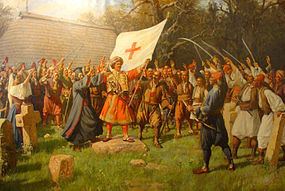 | ||
Similar First Serbian Uprising, Serbian Revolution, Hadži Prodan's revolt, Russo‑Persian War, Battle of Mišar | ||
The second serbian uprising against the ottomans in 1815 1817
The Second Serbian Uprising (1815–1817) was the second phase of the Serbian Revolution against the Ottoman Empire, which erupted shortly after the re-annexation of the country to the Ottoman Empire, in 1813. The occupation was enforced following the defeat of the First Serbian Uprising (1804–1813), during which Serbia existed as a de facto independent state for over a decade. The second revolution ultimately resulted in Serbian semi-independence from the Ottoman Empire. The Principality of Serbia was established, governed by its own parliament, constitution and royal dynasty. De jure independence followed during the second half of the 19th century.
Contents
The second serbian uprising against the ottomans in 1815 1817
Background
The First Serbian Uprising managed to liberate the country for a significant time (1804-1813) from Ottoman Empire; for the first time in three centuries, Serbs governed themselves without the supremacy of the Ottoman Empire or Habsburg Austria.
After the failure of the First Serbian uprising, most commanders escaped to the Habsburg Monarchy; only a few remained in Serbia. Karađorđe Petrović, leader of the First Serbian Uprising, escaped with his family. Despite the efforts of Karađorđe to obtain allies among Austrian Serbs, Bosnian Serbs, Russians, or Napoleon Bonaparte, the rebel Serbian state was crushed by the Ottomans in 1813.
Miloš Obrenović surrendered to the Ottoman Turks and received the title of "obor-knez" ("senior leader"). Stanoje Glavaš also surrendered to the Turks and was made a supervisor of a road, but the Turks killed him after they became suspicious of him. Hadži Prodan Gligorijević knew the Turks would arrest him and so declared an uprising in 1814, but Obrenović felt the time was not right for an uprising and did not provide assistance.
Hadži Prodan's Uprising soon failed and he fled to Austria. After the failure of this revolt, the Turks inflicted more persecution against the Serbs, such as high taxation, forced labor, and rape. In March 1815, Serbs had several meetings and decided upon a new revolt.
Uprising
The national council proclaimed open revolt against the Ottoman Empire in Takovo on 24 April 1815. Miloš Obrenović was chosen as the leader and famously spoke, "Here I am, here you are. War to the Turks!" When the Ottomans discovered the new revolt they sentenced all of its leaders to death. The Serbs fought in battles at Ljubić, Čačak, Palež, Požarevac and Dublje and drove the Ottomans out of the Pashaluk of Belgrade.
In mid-1815, the first negotiations began between Miloš Obrenović and Marashli Ali Pasha, the Ottoman governor. Miloš Obrenović managed to get a form of partial autonomy for Serbs, and, in 1816, the Turkish Porte signed several documents for the normalization of relations between Serbs and Turks. The result was the acknowledgment of a Serbian Principality by the Ottoman Empire. Miloš Obrenović received the title of Prince of Serbia. Although the principality paid a yearly tax to the Porte and had a garrison of Turkish troops in Belgrade until 1867, it was, in most other matters, an independent state. Under the grandson of Miloš's brother, Milan, Serbia gained formal independence in 1878 under the Treaty of Berlin.
In 1817, Miloš Obrenović succeeded in forcing Marashli Ali Pasha to negotiate an unwritten agreement, an act which effeftively ended the Second Serbian uprising. The same year, Karađorđe, the leader of the First Uprising, returned to Serbia and was assassinated.
Aftermath
Serbia's semi-independence was reaffirmed by a Ferman from the Porte in 1830, and in 1835 the first constitution in the Balkans was written in the Principality of Serbia. It introduced Serbian Parliament on the regular basis and established the Obrenović dynasty as the legal heir to the throne of Serbia. It also described Serbia as an independent parliamentary Principality, which outraged the Ottoman Empire and the Habsburg monarchy.
